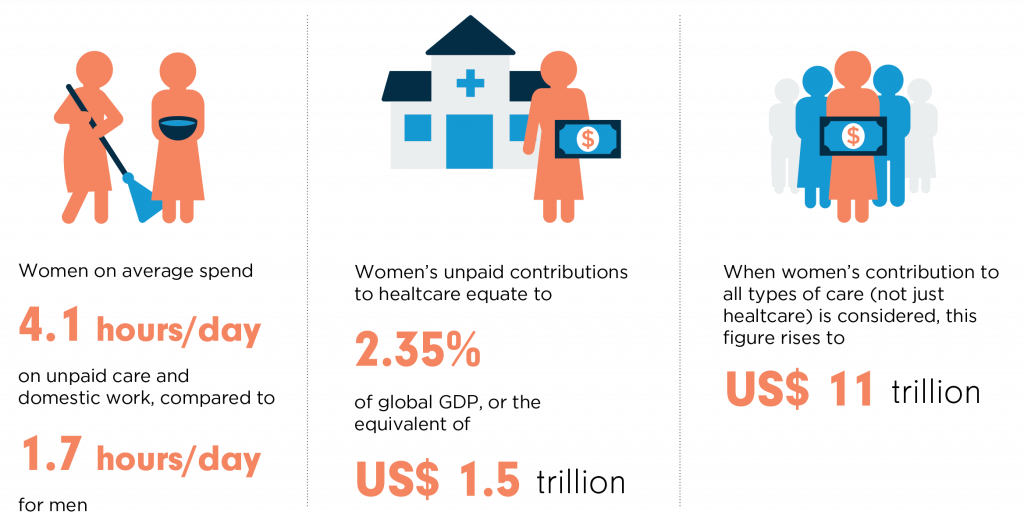ADDRESSING GENDER INEQUITIES IN CARE: IMPLICATIONS FOR WOMEN AND ECONOMY
ADDRESSING GENDER INEQUITIES IN CARE: IMPLICATIONS FOR WOMEN AND ECONOMY
Why in the News?
- Most of the paid and unpaid care work in India is performed by women, highlighting the need for women’s economic empowerment and addressing gender inequities in care.
- Women care workers often face poor pay, long hours, and inadequate work conditions, exemplifying the challenges in women employment and the persistent gender gap in the care sector.
- The issue underscores the ongoing gender inequalities in the division and valuation of care work, impacting women’s role in economic development.
- There is growing attention on the need for policy reforms to recognize, redistribute, and reduce women’s care responsibilities, emphasizing the importance of women empowerment.
Care Work
- Care work — both paid and unpaid — is essential for the health and wellbeing of society and the economy.
- It includes tasks such as child-rearing, elder care, and tending to the sick, which are often considered examples of domestic work.
- This work ensures the daily functioning of households and communities and is crucial for women’s economic empowerment and overall economic growth.
Global Context of Unpaid Care Work
- Globally, women spend an average of 4 hours 25 minutes daily on unpaid care work, compared to 1 hour 23 minutes by men.
- This reflects a significant gender gap in the distribution of unpaid domestic responsibilities and women’s unpaid work.
Gendered Nature of Care Work in India
- The majority of care work in India is carried out by women, impacting their economic empowerment and labour force participation.
- Most of this work is unpaid and remains invisible in economic statistics, contributing to economic inefficiencies and perpetuating gender inequities in care.
- Women’s contribution to care work is often overlooked in policy discussions, despite its importance for women and the economy.
Unpaid Care Work in India
- Time Use Surveys (2019 & 2024) reveal that Indian women spend nearly 10 times more time than men on unpaid domestic tasks and household chores. This women empowerment data highlights the stark gender disparity in care responsibilities.
- Despite its scale and impact, this domestic work is not captured in labour force surveys or national economic data.
Impact on Women’s Opportunities
- Women continue to bear the primary responsibility for child and family care, affecting women in labour and their career prospects.
- This unpaid workload limits their time and access to education, jobs, and economic independence, hindering women’s entrepreneurship and perpetuating the gender gap in economic opportunities.
- The burden of care responsibilities often compromises women’s physical and emotional wellbeing and work-life balance, highlighting why women empowerment is important for societal progress.
Rising Demand for Care Services
- India’s population is ageing rapidly, increasing the need for care services and potentially affecting women migrant workers.
- By 2036, the elderly population (60+ years) is projected to reach 227 million.
- Urbanisation is eroding traditional family-based care systems, creating a care gap and new challenges for women employment.
Economic Invisibility
- Tasks like cooking, cleaning, elder care, and water collection are not included in GDP when done by family members as domestic work.
- The same tasks are recognized as economic activity when performed by paid workers like domestic helpers or nurses.
- This disparity leads to underestimation of women’s economic contributions and reinforces gender inequalities in the care sector.
- According to SBI Research (2023), the estimated value of women’s unpaid labour is ₹22.7 lakh crore:
- ₹14.7 lakh crore in rural areas
- ₹8 lakh crore in urban India
- Recognising this work is essential not only for gender equality but also for national development and women’s role in economic development.
Paid Care Workforce: Global and Indian Snapshot
- ILO estimates the global care workforce includes:
- 248.9 million women
- 132.1 million men
- Includes formal care sector roles (health, education, social work), support staff, and domestic workers.
- In India, the PLFS 2023–24 shows:
- 36 million people are employed in paid care work.
- 56.6% of this workforce are women, highlighting the importance of women employment in this sector.
Working Conditions and Inequities
- Women dominate low-paying, informal, and unprotected roles in the care economy, facing gender discrimination and occupational downgrading.
- More than half the paid care jobs are in education, followed by healthcare and personal care services.
- In domestic and personal care services, over two-thirds of workers are women.
- The care sector is heavily informal. Nearly 99% of paid care jobs lack formal contracts, social security, or protections, contributing to informal employment and exacerbating gender inequities in care.
Social Composition of the Care Workforce
- Over two-thirds of the paid care workforce belong to marginalised communities:
- Scheduled Castes (SCs)
- Scheduled Tribes (STs)
- Other Backward Classes (OBCs)
- This reflects historical and systemic barriers that push these groups into undervalued and poorly paid roles, exacerbating gender inequalities and the gender gap in economic opportunities.
Need for Policy Action
- There is a pressing need to recognize, reduce, and redistribute unpaid care work to promote women’s economic empowerment.
- Investments in care infrastructure and services are essential to close the gender gap and support women in labour.
- Acknowledging care work in policy and economic frameworks is crucial for gender justice and women’s rights, emphasizing the importance of women empowerment.
Regular but Precarious Work
High Regular Employment, Low Security
- 88.7% of paid care workers in India are “regularly employed.”
- However, regular employment often lacks job security and fair compensation, highlighting some of the disadvantages of women empowerment efforts in the care sector.
Prevalence of Informality
- 43% of paid care workers are in the unorganised sector, where benefits like paid leave and social protection are rare.
- Even in the organised sector, 41.4% of jobs are informal.
- Women are disproportionately affected by this informality, impacting their economic empowerment and perpetuating gender inequities in care.
Personal Care Services: Extreme Informality
- 99.5% of jobs are informal.
- 97% of workers lack written contracts.
- Only 19.5% receive paid leave.
Variation in Paid Leave Access
- Overall: Only 52.3% of paid care workers receive paid leave.
- Education sector: 73.6% receive paid leave.
- Personal services: Just 19.5% receive this benefit.
Gender Wage Disparities
- Self-employed care workers earn more than salaried or casual ones.
- However, even among self-employed workers, there is a 61% gender pay gap, highlighting persistent gender inequalities in the care economy.
Sector-Specific Gender Inequality
- Education: Men hold better-paid roles (e.g., administrators, senior faculty); women are in early childhood education and support roles.
- Health: Men are concentrated in higher-paying roles (e.g., doctors); women are mostly nurses or caregivers.
- Domestic/personal services: Lowest earnings and widest gender wage gaps, with jobs being largely unregulated and informal — mostly held by women.
Root Causes of Inequality
- Occupational segregation by gender.
- Deep-rooted gender norms and social norms.
- Limited access to quality education.
- Burden of care responsibilities restricting women’s access to better-paying jobs and hindering women’s entrepreneurship.
Policy Roadmap for a Better Care Economy: Key Measures
Recognise and Measure Unpaid Care Work
- Acknowledge the economic value of unpaid care work, mostly done by women, as part of women’s role in economic development.
- Supplement Time Use Surveys with a dedicated national survey on unpaid care to inform evidence-based policymaking and gather data on economic empowerment of women.
Invest in Public Care Infrastructure
- Scale up affordable and high-quality childcare, eldercare, and community health services.
- Increase public investment in care facilities and supporting infrastructure (e.g., water and sanitation) to reduce women’s burden and generate employment, contributing to economic growth and poverty reduction.
Redistribute Care Within Households
- Promote shared caregiving responsibilities through policies such as:
- Paid parental leave, including maternity leave and paternity leave.
- Public awareness campaigns to shift gender roles around caregiving and highlight the importance of women empowerment.
Formalise and Strengthen Paid Care Jobs
- Recognise care work as skilled labour.
- Formalise employment with:
- Fair wages.
- Legal and social protections.
- Provide skilling/upskilling programs, especially for women in health, education, and personal services sectors, enhancing women’s economic empowerment.
Close Gender Gaps in Pay and Opportunities
- Enforce equal pay for equal work across care sectors to address the gender pay gap.
- Create career pathways to help women move into supervisory and professional roles.
- Expand access to adult education and vocational training to support women’s entrepreneurship.
- Implement flexible work arrangements to help women balance care responsibilities and career advancement.
Plan for India’s Future Care Needs
- Anticipate growing care demands due to an ageing population.
- Align training, employment, and care infrastructure policies accordingly.
- Encourage Public-Private Partnerships (PPPs) and CSR contributions to expand care services and support women’s economic empowerment.
Collaborate for Systemic Reform
- Government must lead but also engage civil society, private sector, and local communities.
- Build a responsive, inclusive, and gender-sensitive care system through collective action, addressing gender inequities in care.
Care work is essential to the functioning of society and the economy, yet it remains undervalued and unequally shared. India must place the recognition, reduction, and redistribution of care work—both paid and unpaid—at the core of its social and economic development strategy. This approach is crucial for achieving women’s economic empowerment, reducing poverty, and promoting sustainable development goals. By addressing these issues, we can showcase positive examples of female empowerment in world and highlight the benefits of women empowerment for society as a whole.
To further explore the topic, one could write a women’s economic empowerment essay detailing the challenges and opportunities in the Indian context. Such an essay could include facts about women empowerment, discuss the advantages and potential disadvantages of women empowerment efforts, and explain why addressing gender inequities in care is important for overall economic growth and poverty reduction.
Mains Question (250 words):
Discuss the challenges and policy imperatives for building a robust and equitable care economy in India. How can recognising, reducing, and redistributing care work promote gender equality and women’s economic empowerment?







